Farming Practices in Clove Tree Based Cropping Systems, Madagascar
VerifiedAdded on 2022/07/05
|21
|9626
|29
Report
AI Summary
This report presents a study conducted in the Fenerive Est district of Madagascar, focusing on the assessment of local knowledge and agricultural practices within clove tree-based cropping systems. The research investigates how farmers, particularly the Bestimisaraka, manage their clove tree plantations and diversify their crops to improve food security. The study explores the influence of both internal and external factors, such as cyclones and price fluctuations, on farmers' decision-making processes regarding their farming systems. The methodology includes surveys, interviews, focus groups, and participatory rural appraisal methods to gather qualitative data. The findings reveal that farmers adopt different cropping systems based on land size, number of clove trees, and other factors, including the need to produce enough rice for their families. The research identifies the socio-economic backgrounds of the farmers, including their age, gender, education level, and land rights, as significant variables influencing their farming practices. The report also analyzes the evolution of clove tree cropping systems, from monocultures to parklands and agroforestry systems, highlighting the importance of local knowledge in adapting to environmental and socio-economic changes.
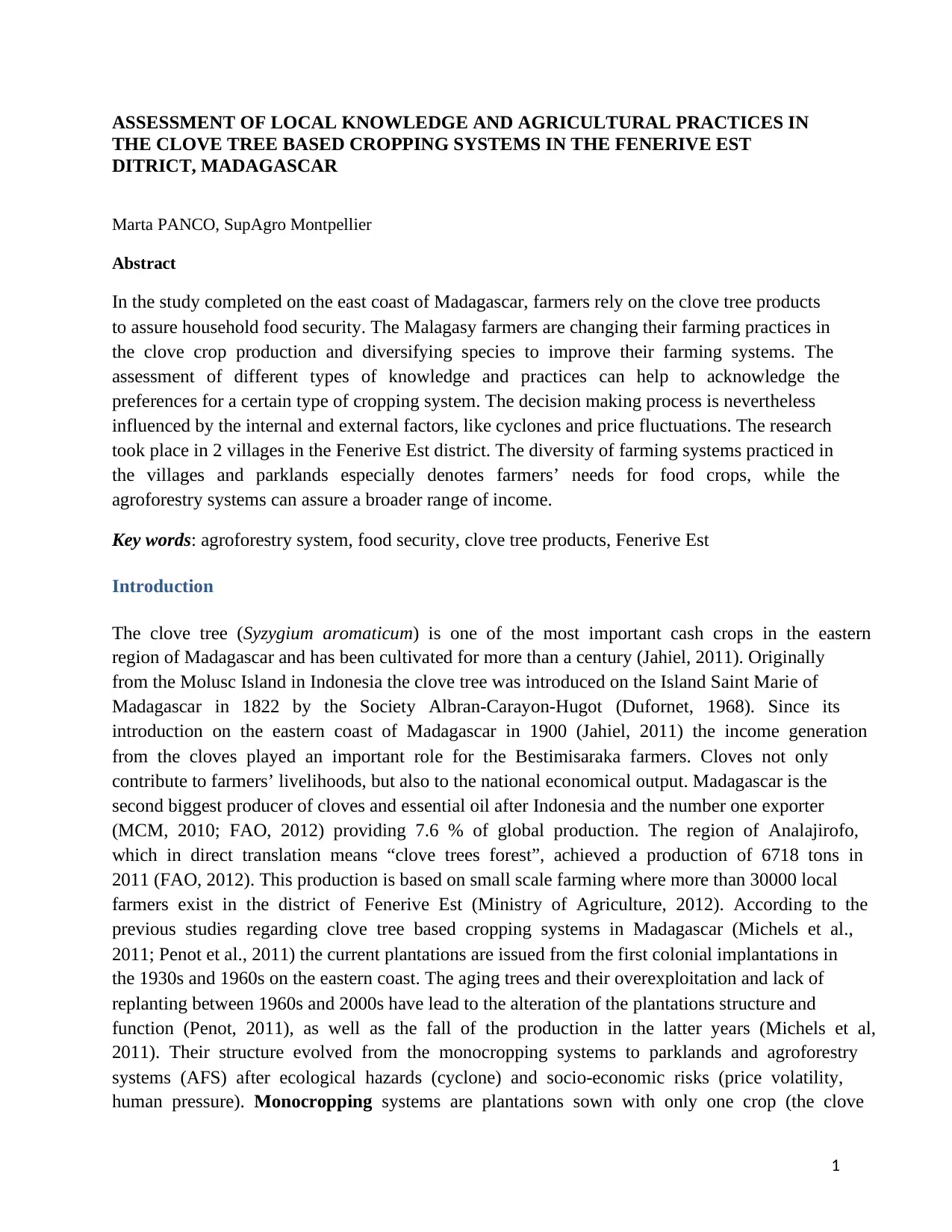
1
ASSESSMENT OF LOCAL KNOWLEDGE AND AGRICULTURAL PRACTICES IN
THE CLOVE TREE BASED CROPPING SYSTEMS IN THE FENERIVE EST
DITRICT, MADAGASCAR
Marta PANCO, SupAgro Montpellier
Abstract
In the study completed on the east coast of Madagascar, farmers rely on the clove tree products
to assure household food security. The Malagasy farmers are changing their farming practices in
the clove crop production and diversifying species to improve their farming systems. The
assessment of different types of knowledge and practices can help to acknowledge the
preferences for a certain type of cropping system. The decision making process is nevertheless
influenced by the internal and external factors, like cyclones and price fluctuations. The research
took place in 2 villages in the Fenerive Est district. The diversity of farming systems practiced in
the villages and parklands especially denotes farmers’ needs for food crops, while the
agroforestry systems can assure a broader range of income.
Key words: agroforestry system, food security, clove tree products, Fenerive Est
Introduction
The clove tree (Syzygium aromaticum) is one of the most important cash crops in the eastern
region of Madagascar and has been cultivated for more than a century (Jahiel, 2011). Originally
from the Molusc Island in Indonesia the clove tree was introduced on the Island Saint Marie of
Madagascar in 1822 by the Society Albran-Carayon-Hugot (Dufornet, 1968). Since its
introduction on the eastern coast of Madagascar in 1900 (Jahiel, 2011) the income generation
from the cloves played an important role for the Bestimisaraka farmers. Cloves not only
contribute to farmers’ livelihoods, but also to the national economical output. Madagascar is the
second biggest producer of cloves and essential oil after Indonesia and the number one exporter
(MCM, 2010; FAO, 2012) providing 7.6 % of global production. The region of Analajirofo,
which in direct translation means “clove trees forest”, achieved a production of 6718 tons in
2011 (FAO, 2012). This production is based on small scale farming where more than 30000 local
farmers exist in the district of Fenerive Est (Ministry of Agriculture, 2012). According to the
previous studies regarding clove tree based cropping systems in Madagascar (Michels et al.,
2011; Penot et al., 2011) the current plantations are issued from the first colonial implantations in
the 1930s and 1960s on the eastern coast. The aging trees and their overexploitation and lack of
replanting between 1960s and 2000s have lead to the alteration of the plantations structure and
function (Penot, 2011), as well as the fall of the production in the latter years (Michels et al,
2011). Their structure evolved from the monocropping systems to parklands and agroforestry
systems (AFS) after ecological hazards (cyclone) and socio-economic risks (price volatility,
human pressure). Monocropping systems are plantations sown with only one crop (the clove
ASSESSMENT OF LOCAL KNOWLEDGE AND AGRICULTURAL PRACTICES IN
THE CLOVE TREE BASED CROPPING SYSTEMS IN THE FENERIVE EST
DITRICT, MADAGASCAR
Marta PANCO, SupAgro Montpellier
Abstract
In the study completed on the east coast of Madagascar, farmers rely on the clove tree products
to assure household food security. The Malagasy farmers are changing their farming practices in
the clove crop production and diversifying species to improve their farming systems. The
assessment of different types of knowledge and practices can help to acknowledge the
preferences for a certain type of cropping system. The decision making process is nevertheless
influenced by the internal and external factors, like cyclones and price fluctuations. The research
took place in 2 villages in the Fenerive Est district. The diversity of farming systems practiced in
the villages and parklands especially denotes farmers’ needs for food crops, while the
agroforestry systems can assure a broader range of income.
Key words: agroforestry system, food security, clove tree products, Fenerive Est
Introduction
The clove tree (Syzygium aromaticum) is one of the most important cash crops in the eastern
region of Madagascar and has been cultivated for more than a century (Jahiel, 2011). Originally
from the Molusc Island in Indonesia the clove tree was introduced on the Island Saint Marie of
Madagascar in 1822 by the Society Albran-Carayon-Hugot (Dufornet, 1968). Since its
introduction on the eastern coast of Madagascar in 1900 (Jahiel, 2011) the income generation
from the cloves played an important role for the Bestimisaraka farmers. Cloves not only
contribute to farmers’ livelihoods, but also to the national economical output. Madagascar is the
second biggest producer of cloves and essential oil after Indonesia and the number one exporter
(MCM, 2010; FAO, 2012) providing 7.6 % of global production. The region of Analajirofo,
which in direct translation means “clove trees forest”, achieved a production of 6718 tons in
2011 (FAO, 2012). This production is based on small scale farming where more than 30000 local
farmers exist in the district of Fenerive Est (Ministry of Agriculture, 2012). According to the
previous studies regarding clove tree based cropping systems in Madagascar (Michels et al.,
2011; Penot et al., 2011) the current plantations are issued from the first colonial implantations in
the 1930s and 1960s on the eastern coast. The aging trees and their overexploitation and lack of
replanting between 1960s and 2000s have lead to the alteration of the plantations structure and
function (Penot, 2011), as well as the fall of the production in the latter years (Michels et al,
2011). Their structure evolved from the monocropping systems to parklands and agroforestry
systems (AFS) after ecological hazards (cyclone) and socio-economic risks (price volatility,
human pressure). Monocropping systems are plantations sown with only one crop (the clove
Paraphrase This Document
Need a fresh take? Get an instant paraphrase of this document with our AI Paraphraser
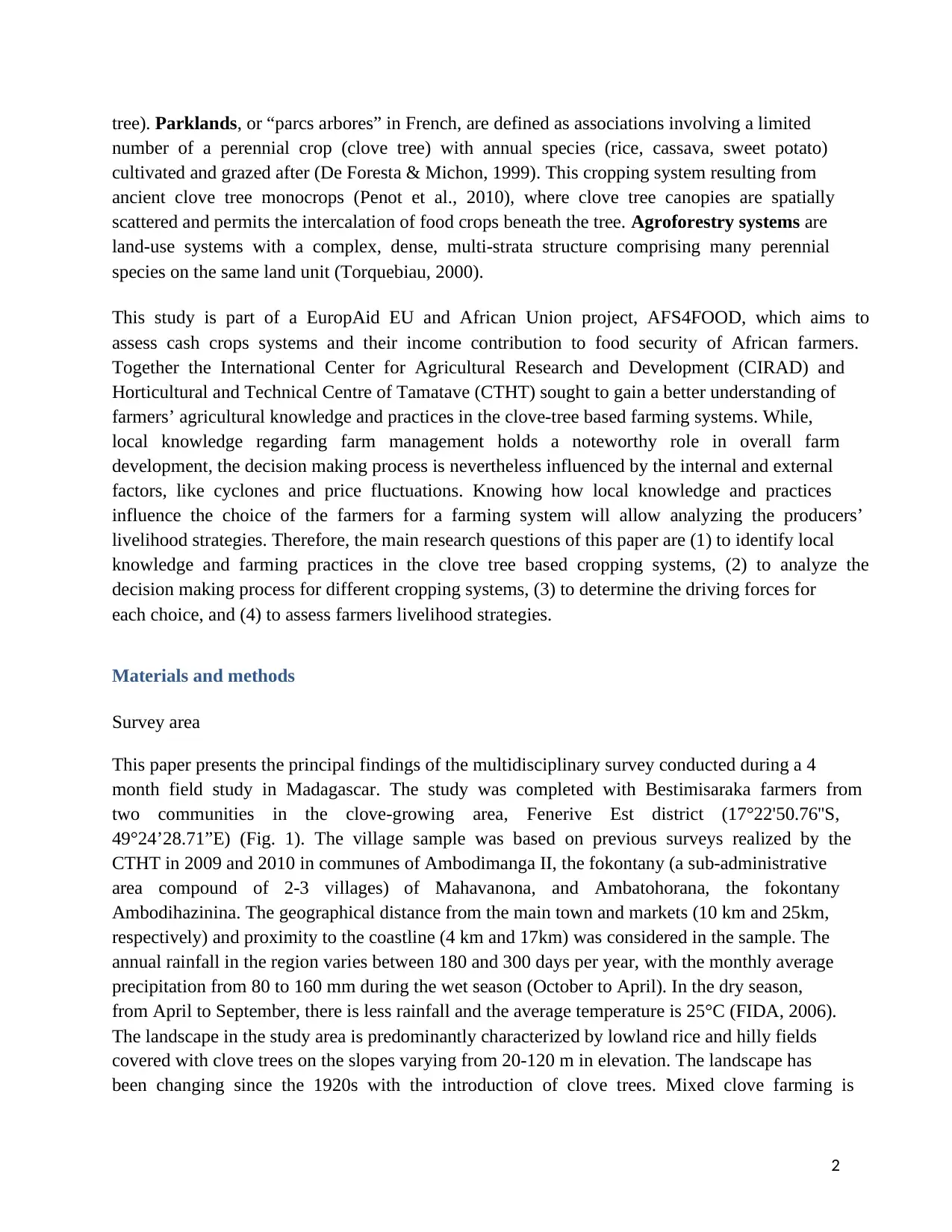
2
tree). Parklands, or “parcs arbores” in French, are defined as associations involving a limited
number of a perennial crop (clove tree) with annual species (rice, cassava, sweet potato)
cultivated and grazed after (De Foresta & Michon, 1999). This cropping system resulting from
ancient clove tree monocrops (Penot et al., 2010), where clove tree canopies are spatially
scattered and permits the intercalation of food crops beneath the tree. Agroforestry systems are
land-use systems with a complex, dense, multi-strata structure comprising many perennial
species on the same land unit (Torquebiau, 2000).
This study is part of a EuropAid EU and African Union project, AFS4FOOD, which aims to
assess cash crops systems and their income contribution to food security of African farmers.
Together the International Center for Agricultural Research and Development (CIRAD) and
Horticultural and Technical Centre of Tamatave (CTHT) sought to gain a better understanding of
farmers’ agricultural knowledge and practices in the clove-tree based farming systems. While,
local knowledge regarding farm management holds a noteworthy role in overall farm
development, the decision making process is nevertheless influenced by the internal and external
factors, like cyclones and price fluctuations. Knowing how local knowledge and practices
influence the choice of the farmers for a farming system will allow analyzing the producers’
livelihood strategies. Therefore, the main research questions of this paper are (1) to identify local
knowledge and farming practices in the clove tree based cropping systems, (2) to analyze the
decision making process for different cropping systems, (3) to determine the driving forces for
each choice, and (4) to assess farmers livelihood strategies.
Materials and methods
Survey area
This paper presents the principal findings of the multidisciplinary survey conducted during a 4
month field study in Madagascar. The study was completed with Bestimisaraka farmers from
two communities in the clove-growing area, Fenerive Est district (17°22'50.76''S,
49°24’28.71”E) (Fig. 1). The village sample was based on previous surveys realized by the
CTHT in 2009 and 2010 in communes of Ambodimanga II, the fokontany (a sub-administrative
area compound of 2-3 villages) of Mahavanona, and Ambatohorana, the fokontany
Ambodihazinina. The geographical distance from the main town and markets (10 km and 25km,
respectively) and proximity to the coastline (4 km and 17km) was considered in the sample. The
annual rainfall in the region varies between 180 and 300 days per year, with the monthly average
precipitation from 80 to 160 mm during the wet season (October to April). In the dry season,
from April to September, there is less rainfall and the average temperature is 25°C (FIDA, 2006).
The landscape in the study area is predominantly characterized by lowland rice and hilly fields
covered with clove trees on the slopes varying from 20-120 m in elevation. The landscape has
been changing since the 1920s with the introduction of clove trees. Mixed clove farming is
tree). Parklands, or “parcs arbores” in French, are defined as associations involving a limited
number of a perennial crop (clove tree) with annual species (rice, cassava, sweet potato)
cultivated and grazed after (De Foresta & Michon, 1999). This cropping system resulting from
ancient clove tree monocrops (Penot et al., 2010), where clove tree canopies are spatially
scattered and permits the intercalation of food crops beneath the tree. Agroforestry systems are
land-use systems with a complex, dense, multi-strata structure comprising many perennial
species on the same land unit (Torquebiau, 2000).
This study is part of a EuropAid EU and African Union project, AFS4FOOD, which aims to
assess cash crops systems and their income contribution to food security of African farmers.
Together the International Center for Agricultural Research and Development (CIRAD) and
Horticultural and Technical Centre of Tamatave (CTHT) sought to gain a better understanding of
farmers’ agricultural knowledge and practices in the clove-tree based farming systems. While,
local knowledge regarding farm management holds a noteworthy role in overall farm
development, the decision making process is nevertheless influenced by the internal and external
factors, like cyclones and price fluctuations. Knowing how local knowledge and practices
influence the choice of the farmers for a farming system will allow analyzing the producers’
livelihood strategies. Therefore, the main research questions of this paper are (1) to identify local
knowledge and farming practices in the clove tree based cropping systems, (2) to analyze the
decision making process for different cropping systems, (3) to determine the driving forces for
each choice, and (4) to assess farmers livelihood strategies.
Materials and methods
Survey area
This paper presents the principal findings of the multidisciplinary survey conducted during a 4
month field study in Madagascar. The study was completed with Bestimisaraka farmers from
two communities in the clove-growing area, Fenerive Est district (17°22'50.76''S,
49°24’28.71”E) (Fig. 1). The village sample was based on previous surveys realized by the
CTHT in 2009 and 2010 in communes of Ambodimanga II, the fokontany (a sub-administrative
area compound of 2-3 villages) of Mahavanona, and Ambatohorana, the fokontany
Ambodihazinina. The geographical distance from the main town and markets (10 km and 25km,
respectively) and proximity to the coastline (4 km and 17km) was considered in the sample. The
annual rainfall in the region varies between 180 and 300 days per year, with the monthly average
precipitation from 80 to 160 mm during the wet season (October to April). In the dry season,
from April to September, there is less rainfall and the average temperature is 25°C (FIDA, 2006).
The landscape in the study area is predominantly characterized by lowland rice and hilly fields
covered with clove trees on the slopes varying from 20-120 m in elevation. The landscape has
been changing since the 1920s with the introduction of clove trees. Mixed clove farming is
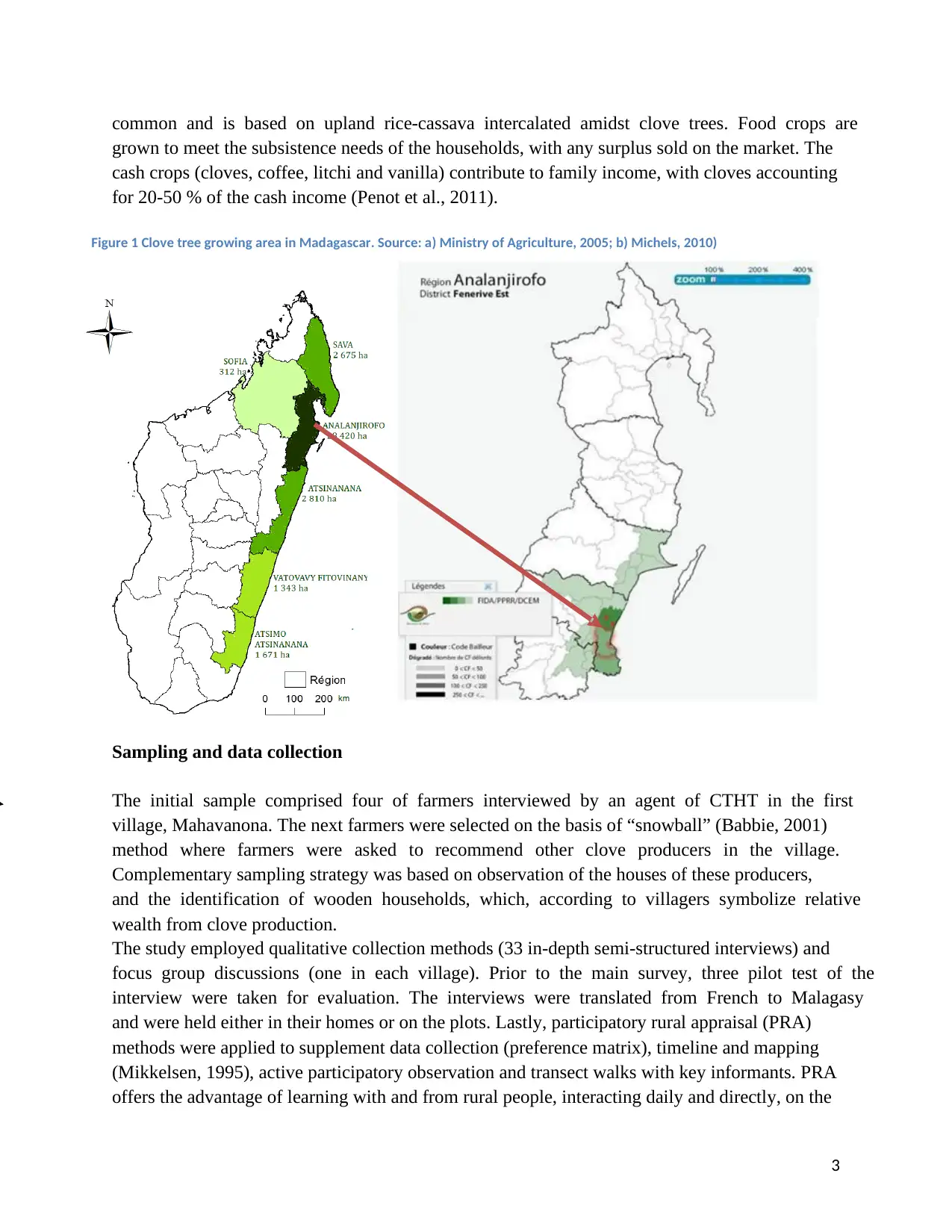
3
common and is based on upland rice-cassava intercalated amidst clove trees. Food crops are
grown to meet the subsistence needs of the households, with any surplus sold on the market. The
cash crops (cloves, coffee, litchi and vanilla) contribute to family income, with cloves accounting
for 20-50 % of the cash income (Penot et al., 2011).
Sampling and data collection
The initial sample comprised four of farmers interviewed by an agent of CTHT in the first
village, Mahavanona. The next farmers were selected on the basis of “snowball” (Babbie, 2001)
method where farmers were asked to recommend other clove producers in the village.
Complementary sampling strategy was based on observation of the houses of these producers,
and the identification of wooden households, which, according to villagers symbolize relative
wealth from clove production.
The study employed qualitative collection methods (33 in-depth semi-structured interviews) and
focus group discussions (one in each village). Prior to the main survey, three pilot test of the
interview were taken for evaluation. The interviews were translated from French to Malagasy
and were held either in their homes or on the plots. Lastly, participatory rural appraisal (PRA)
methods were applied to supplement data collection (preference matrix), timeline and mapping
(Mikkelsen, 1995), active participatory observation and transect walks with key informants. PRA
offers the advantage of learning with and from rural people, interacting daily and directly, on the
Figure 1 Clove tree growing area in Madagascar. Source: a) Ministry of Agriculture, 2005; b) Michels, 2010)
common and is based on upland rice-cassava intercalated amidst clove trees. Food crops are
grown to meet the subsistence needs of the households, with any surplus sold on the market. The
cash crops (cloves, coffee, litchi and vanilla) contribute to family income, with cloves accounting
for 20-50 % of the cash income (Penot et al., 2011).
Sampling and data collection
The initial sample comprised four of farmers interviewed by an agent of CTHT in the first
village, Mahavanona. The next farmers were selected on the basis of “snowball” (Babbie, 2001)
method where farmers were asked to recommend other clove producers in the village.
Complementary sampling strategy was based on observation of the houses of these producers,
and the identification of wooden households, which, according to villagers symbolize relative
wealth from clove production.
The study employed qualitative collection methods (33 in-depth semi-structured interviews) and
focus group discussions (one in each village). Prior to the main survey, three pilot test of the
interview were taken for evaluation. The interviews were translated from French to Malagasy
and were held either in their homes or on the plots. Lastly, participatory rural appraisal (PRA)
methods were applied to supplement data collection (preference matrix), timeline and mapping
(Mikkelsen, 1995), active participatory observation and transect walks with key informants. PRA
offers the advantage of learning with and from rural people, interacting daily and directly, on the
Figure 1 Clove tree growing area in Madagascar. Source: a) Ministry of Agriculture, 2005; b) Michels, 2010)
⊘ This is a preview!⊘
Do you want full access?
Subscribe today to unlock all pages.

Trusted by 1+ million students worldwide
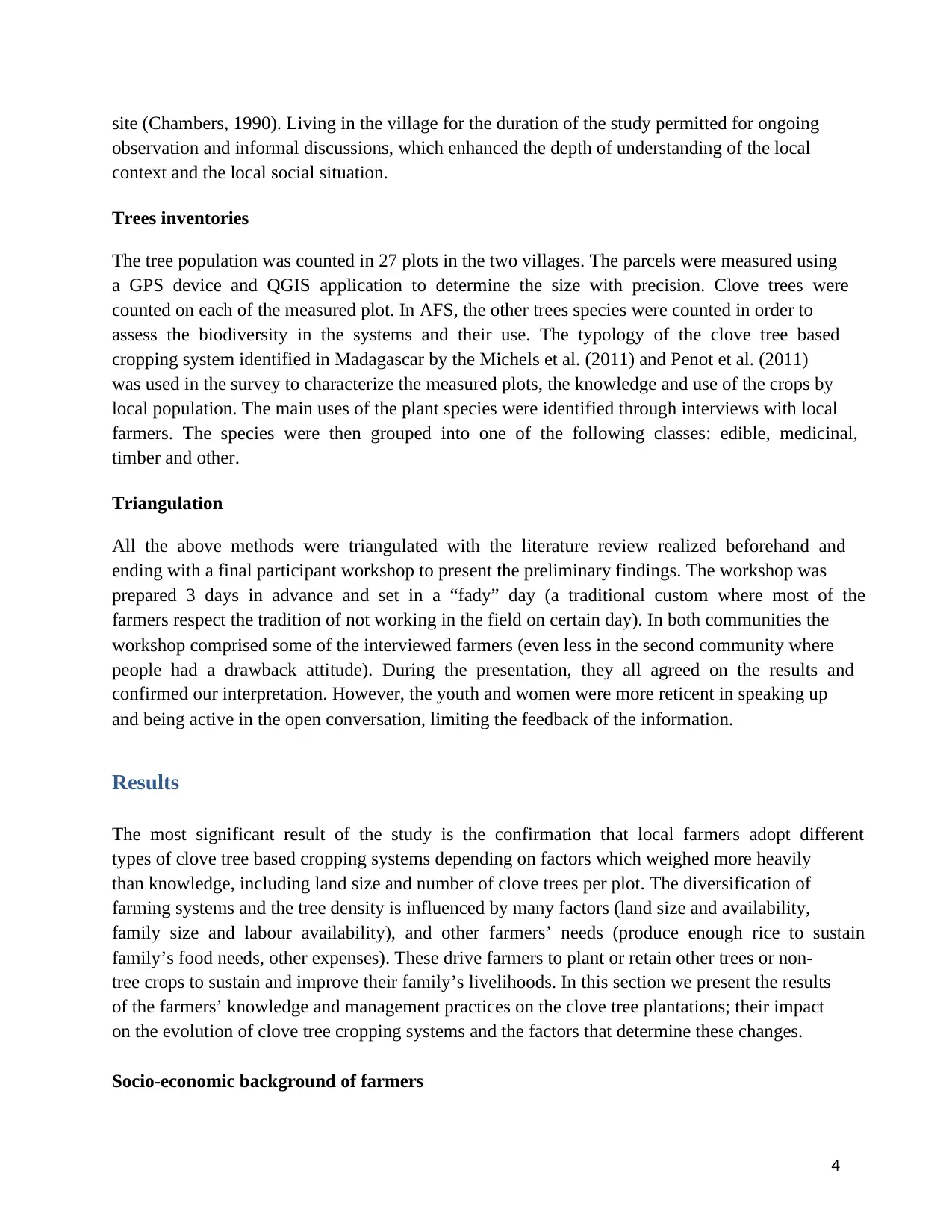
4
site (Chambers, 1990). Living in the village for the duration of the study permitted for ongoing
observation and informal discussions, which enhanced the depth of understanding of the local
context and the local social situation.
Trees inventories
The tree population was counted in 27 plots in the two villages. The parcels were measured using
a GPS device and QGIS application to determine the size with precision. Clove trees were
counted on each of the measured plot. In AFS, the other trees species were counted in order to
assess the biodiversity in the systems and their use. The typology of the clove tree based
cropping system identified in Madagascar by the Michels et al. (2011) and Penot et al. (2011)
was used in the survey to characterize the measured plots, the knowledge and use of the crops by
local population. The main uses of the plant species were identified through interviews with local
farmers. The species were then grouped into one of the following classes: edible, medicinal,
timber and other.
Triangulation
All the above methods were triangulated with the literature review realized beforehand and
ending with a final participant workshop to present the preliminary findings. The workshop was
prepared 3 days in advance and set in a “fady” day (a traditional custom where most of the
farmers respect the tradition of not working in the field on certain day). In both communities the
workshop comprised some of the interviewed farmers (even less in the second community where
people had a drawback attitude). During the presentation, they all agreed on the results and
confirmed our interpretation. However, the youth and women were more reticent in speaking up
and being active in the open conversation, limiting the feedback of the information.
Results
The most significant result of the study is the confirmation that local farmers adopt different
types of clove tree based cropping systems depending on factors which weighed more heavily
than knowledge, including land size and number of clove trees per plot. The diversification of
farming systems and the tree density is influenced by many factors (land size and availability,
family size and labour availability), and other farmers’ needs (produce enough rice to sustain
family’s food needs, other expenses). These drive farmers to plant or retain other trees or non-
tree crops to sustain and improve their family’s livelihoods. In this section we present the results
of the farmers’ knowledge and management practices on the clove tree plantations; their impact
on the evolution of clove tree cropping systems and the factors that determine these changes.
Socio-economic background of farmers
site (Chambers, 1990). Living in the village for the duration of the study permitted for ongoing
observation and informal discussions, which enhanced the depth of understanding of the local
context and the local social situation.
Trees inventories
The tree population was counted in 27 plots in the two villages. The parcels were measured using
a GPS device and QGIS application to determine the size with precision. Clove trees were
counted on each of the measured plot. In AFS, the other trees species were counted in order to
assess the biodiversity in the systems and their use. The typology of the clove tree based
cropping system identified in Madagascar by the Michels et al. (2011) and Penot et al. (2011)
was used in the survey to characterize the measured plots, the knowledge and use of the crops by
local population. The main uses of the plant species were identified through interviews with local
farmers. The species were then grouped into one of the following classes: edible, medicinal,
timber and other.
Triangulation
All the above methods were triangulated with the literature review realized beforehand and
ending with a final participant workshop to present the preliminary findings. The workshop was
prepared 3 days in advance and set in a “fady” day (a traditional custom where most of the
farmers respect the tradition of not working in the field on certain day). In both communities the
workshop comprised some of the interviewed farmers (even less in the second community where
people had a drawback attitude). During the presentation, they all agreed on the results and
confirmed our interpretation. However, the youth and women were more reticent in speaking up
and being active in the open conversation, limiting the feedback of the information.
Results
The most significant result of the study is the confirmation that local farmers adopt different
types of clove tree based cropping systems depending on factors which weighed more heavily
than knowledge, including land size and number of clove trees per plot. The diversification of
farming systems and the tree density is influenced by many factors (land size and availability,
family size and labour availability), and other farmers’ needs (produce enough rice to sustain
family’s food needs, other expenses). These drive farmers to plant or retain other trees or non-
tree crops to sustain and improve their family’s livelihoods. In this section we present the results
of the farmers’ knowledge and management practices on the clove tree plantations; their impact
on the evolution of clove tree cropping systems and the factors that determine these changes.
Socio-economic background of farmers
Paraphrase This Document
Need a fresh take? Get an instant paraphrase of this document with our AI Paraphraser
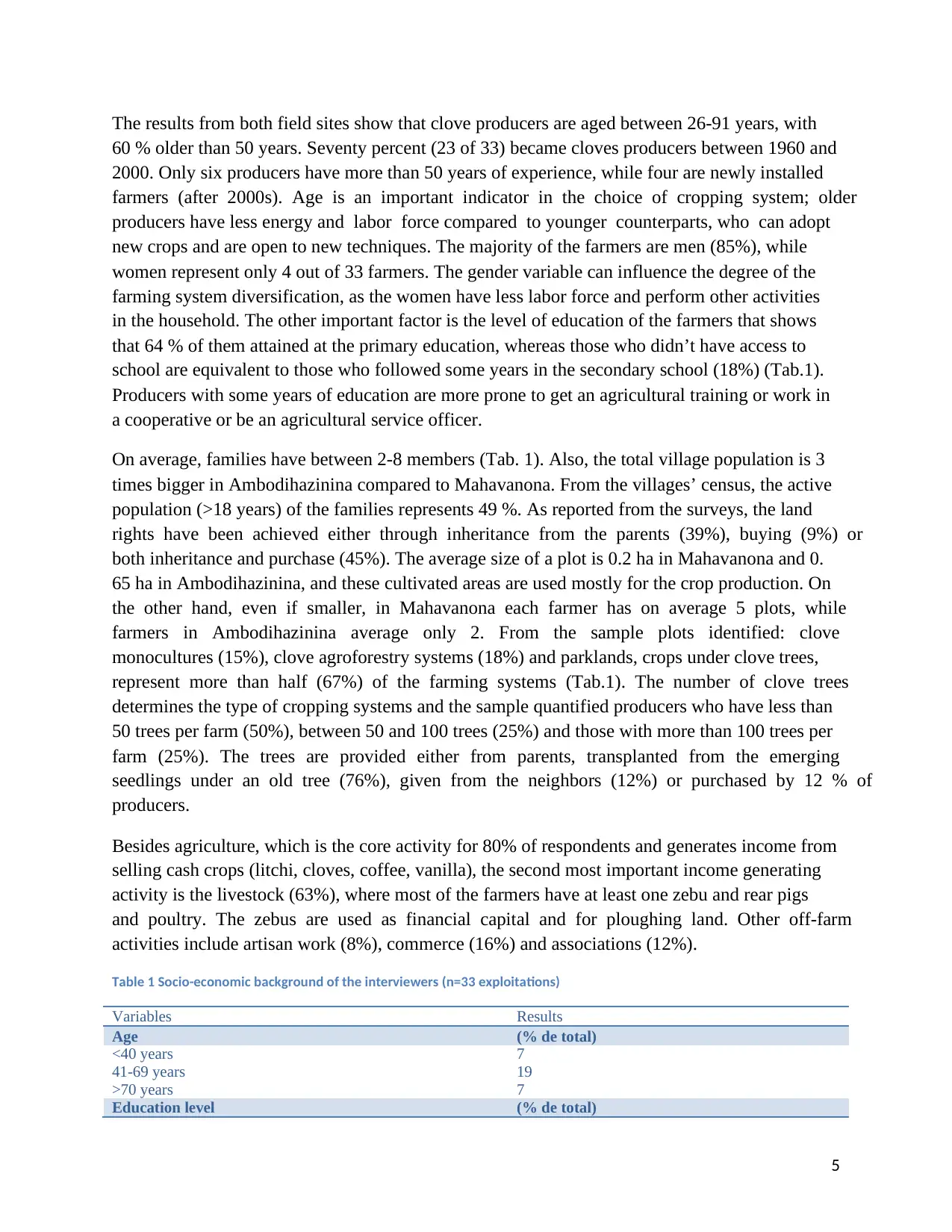
5
The results from both field sites show that clove producers are aged between 26-91 years, with
60 % older than 50 years. Seventy percent (23 of 33) became cloves producers between 1960 and
2000. Only six producers have more than 50 years of experience, while four are newly installed
farmers (after 2000s). Age is an important indicator in the choice of cropping system; older
producers have less energy and labor force compared to younger counterparts, who can adopt
new crops and are open to new techniques. The majority of the farmers are men (85%), while
women represent only 4 out of 33 farmers. The gender variable can influence the degree of the
farming system diversification, as the women have less labor force and perform other activities
in the household. The other important factor is the level of education of the farmers that shows
that 64 % of them attained at the primary education, whereas those who didn’t have access to
school are equivalent to those who followed some years in the secondary school (18%) (Tab.1).
Producers with some years of education are more prone to get an agricultural training or work in
a cooperative or be an agricultural service officer.
On average, families have between 2-8 members (Tab. 1). Also, the total village population is 3
times bigger in Ambodihazinina compared to Mahavanona. From the villages’ census, the active
population (>18 years) of the families represents 49 %. As reported from the surveys, the land
rights have been achieved either through inheritance from the parents (39%), buying (9%) or
both inheritance and purchase (45%). The average size of a plot is 0.2 ha in Mahavanona and 0.
65 ha in Ambodihazinina, and these cultivated areas are used mostly for the crop production. On
the other hand, even if smaller, in Mahavanona each farmer has on average 5 plots, while
farmers in Ambodihazinina average only 2. From the sample plots identified: clove
monocultures (15%), clove agroforestry systems (18%) and parklands, crops under clove trees,
represent more than half (67%) of the farming systems (Tab.1). The number of clove trees
determines the type of cropping systems and the sample quantified producers who have less than
50 trees per farm (50%), between 50 and 100 trees (25%) and those with more than 100 trees per
farm (25%). The trees are provided either from parents, transplanted from the emerging
seedlings under an old tree (76%), given from the neighbors (12%) or purchased by 12 % of
producers.
Besides agriculture, which is the core activity for 80% of respondents and generates income from
selling cash crops (litchi, cloves, coffee, vanilla), the second most important income generating
activity is the livestock (63%), where most of the farmers have at least one zebu and rear pigs
and poultry. The zebus are used as financial capital and for ploughing land. Other off-farm
activities include artisan work (8%), commerce (16%) and associations (12%).
Table 1 Socio-economic background of the interviewers (n=33 exploitations)
Variables Results
Age (% de total)
<40 years
41-69 years
>70 years
7
19
7
Education level (% de total)
The results from both field sites show that clove producers are aged between 26-91 years, with
60 % older than 50 years. Seventy percent (23 of 33) became cloves producers between 1960 and
2000. Only six producers have more than 50 years of experience, while four are newly installed
farmers (after 2000s). Age is an important indicator in the choice of cropping system; older
producers have less energy and labor force compared to younger counterparts, who can adopt
new crops and are open to new techniques. The majority of the farmers are men (85%), while
women represent only 4 out of 33 farmers. The gender variable can influence the degree of the
farming system diversification, as the women have less labor force and perform other activities
in the household. The other important factor is the level of education of the farmers that shows
that 64 % of them attained at the primary education, whereas those who didn’t have access to
school are equivalent to those who followed some years in the secondary school (18%) (Tab.1).
Producers with some years of education are more prone to get an agricultural training or work in
a cooperative or be an agricultural service officer.
On average, families have between 2-8 members (Tab. 1). Also, the total village population is 3
times bigger in Ambodihazinina compared to Mahavanona. From the villages’ census, the active
population (>18 years) of the families represents 49 %. As reported from the surveys, the land
rights have been achieved either through inheritance from the parents (39%), buying (9%) or
both inheritance and purchase (45%). The average size of a plot is 0.2 ha in Mahavanona and 0.
65 ha in Ambodihazinina, and these cultivated areas are used mostly for the crop production. On
the other hand, even if smaller, in Mahavanona each farmer has on average 5 plots, while
farmers in Ambodihazinina average only 2. From the sample plots identified: clove
monocultures (15%), clove agroforestry systems (18%) and parklands, crops under clove trees,
represent more than half (67%) of the farming systems (Tab.1). The number of clove trees
determines the type of cropping systems and the sample quantified producers who have less than
50 trees per farm (50%), between 50 and 100 trees (25%) and those with more than 100 trees per
farm (25%). The trees are provided either from parents, transplanted from the emerging
seedlings under an old tree (76%), given from the neighbors (12%) or purchased by 12 % of
producers.
Besides agriculture, which is the core activity for 80% of respondents and generates income from
selling cash crops (litchi, cloves, coffee, vanilla), the second most important income generating
activity is the livestock (63%), where most of the farmers have at least one zebu and rear pigs
and poultry. The zebus are used as financial capital and for ploughing land. Other off-farm
activities include artisan work (8%), commerce (16%) and associations (12%).
Table 1 Socio-economic background of the interviewers (n=33 exploitations)
Variables Results
Age (% de total)
<40 years
41-69 years
>70 years
7
19
7
Education level (% de total)
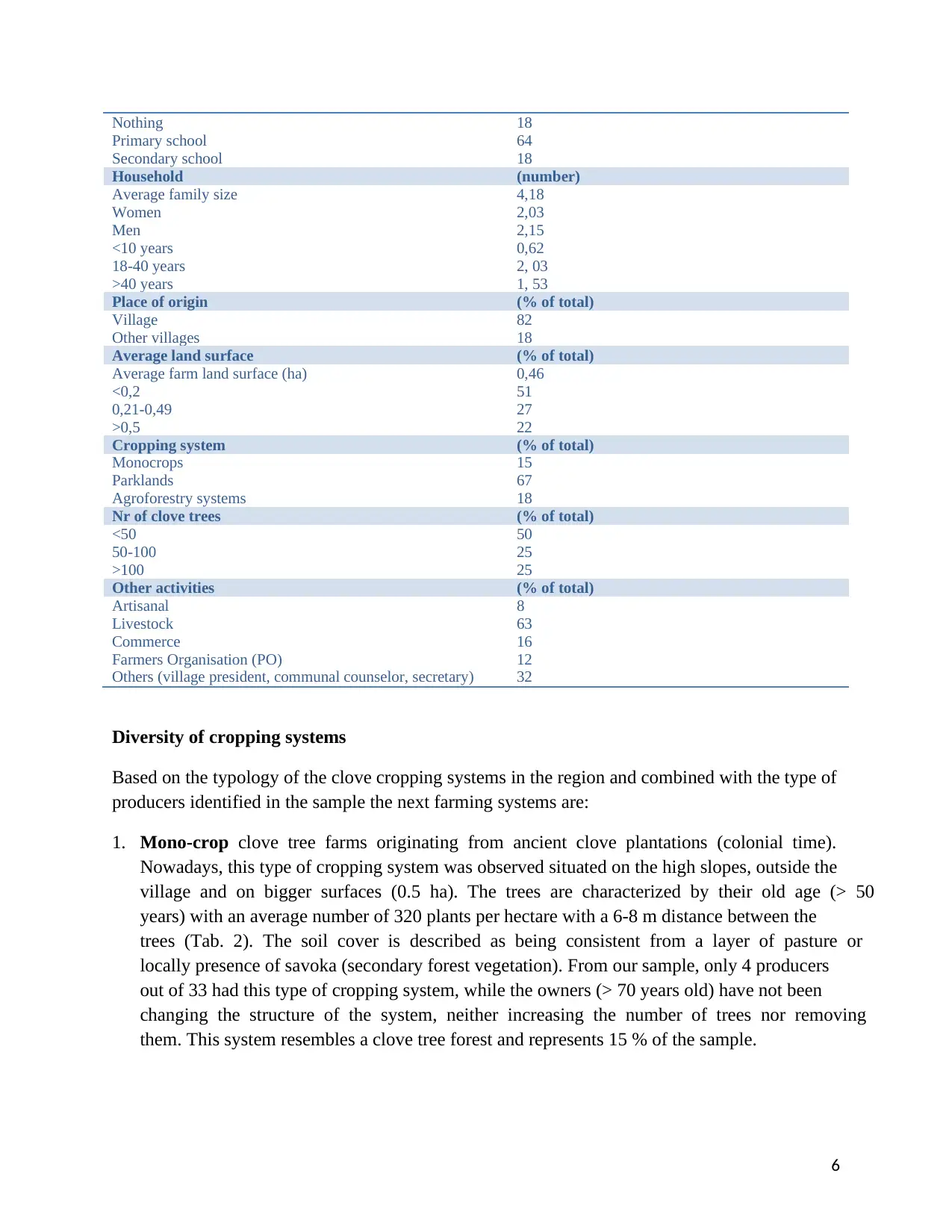
6
Nothing
Primary school
Secondary school
18
64
18
Household (number)
Average family size
Women
Men
<10 years
18-40 years
>40 years
4,18
2,03
2,15
0,62
2, 03
1, 53
Place of origin (% of total)
Village
Other villages
82
18
Average land surface (% of total)
Average farm land surface (ha)
<0,2
0,21-0,49
>0,5
0,46
51
27
22
Cropping system (% of total)
Monocrops
Parklands
Agroforestry systems
15
67
18
Nr of clove trees (% of total)
<50
50-100
>100
50
25
25
Other activities (% of total)
Artisanal
Livestock
Commerce
Farmers Organisation (PO)
Others (village president, communal counselor, secretary)
8
63
16
12
32
Diversity of cropping systems
Based on the typology of the clove cropping systems in the region and combined with the type of
producers identified in the sample the next farming systems are:
1. Mono-crop clove tree farms originating from ancient clove plantations (colonial time).
Nowadays, this type of cropping system was observed situated on the high slopes, outside the
village and on bigger surfaces (0.5 ha). The trees are characterized by their old age (> 50
years) with an average number of 320 plants per hectare with a 6-8 m distance between the
trees (Tab. 2). The soil cover is described as being consistent from a layer of pasture or
locally presence of savoka (secondary forest vegetation). From our sample, only 4 producers
out of 33 had this type of cropping system, while the owners (> 70 years old) have not been
changing the structure of the system, neither increasing the number of trees nor removing
them. This system resembles a clove tree forest and represents 15 % of the sample.
Nothing
Primary school
Secondary school
18
64
18
Household (number)
Average family size
Women
Men
<10 years
18-40 years
>40 years
4,18
2,03
2,15
0,62
2, 03
1, 53
Place of origin (% of total)
Village
Other villages
82
18
Average land surface (% of total)
Average farm land surface (ha)
<0,2
0,21-0,49
>0,5
0,46
51
27
22
Cropping system (% of total)
Monocrops
Parklands
Agroforestry systems
15
67
18
Nr of clove trees (% of total)
<50
50-100
>100
50
25
25
Other activities (% of total)
Artisanal
Livestock
Commerce
Farmers Organisation (PO)
Others (village president, communal counselor, secretary)
8
63
16
12
32
Diversity of cropping systems
Based on the typology of the clove cropping systems in the region and combined with the type of
producers identified in the sample the next farming systems are:
1. Mono-crop clove tree farms originating from ancient clove plantations (colonial time).
Nowadays, this type of cropping system was observed situated on the high slopes, outside the
village and on bigger surfaces (0.5 ha). The trees are characterized by their old age (> 50
years) with an average number of 320 plants per hectare with a 6-8 m distance between the
trees (Tab. 2). The soil cover is described as being consistent from a layer of pasture or
locally presence of savoka (secondary forest vegetation). From our sample, only 4 producers
out of 33 had this type of cropping system, while the owners (> 70 years old) have not been
changing the structure of the system, neither increasing the number of trees nor removing
them. This system resembles a clove tree forest and represents 15 % of the sample.
⊘ This is a preview!⊘
Do you want full access?
Subscribe today to unlock all pages.

Trusted by 1+ million students worldwide
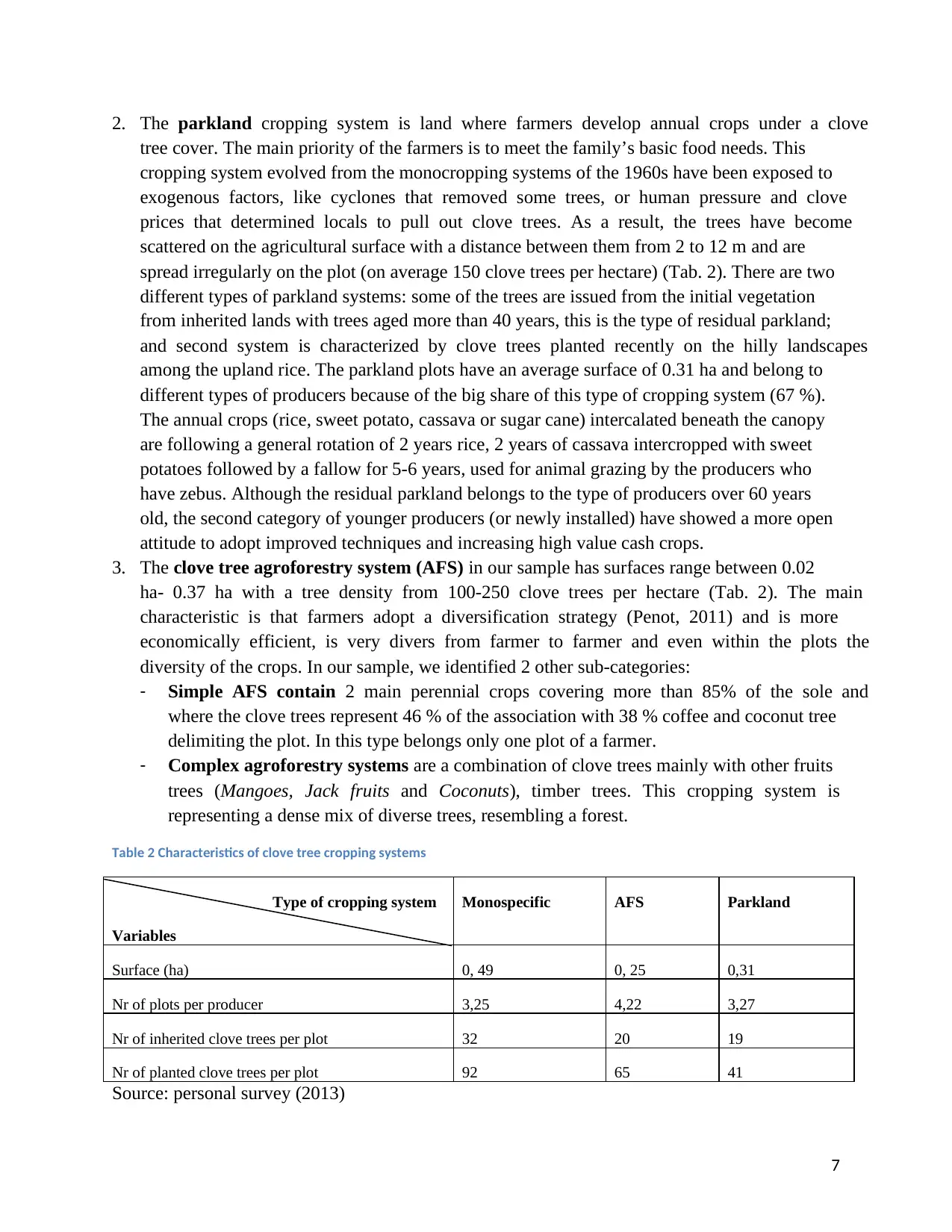
7
2. The parkland cropping system is land where farmers develop annual crops under a clove
tree cover. The main priority of the farmers is to meet the family’s basic food needs. This
cropping system evolved from the monocropping systems of the 1960s have been exposed to
exogenous factors, like cyclones that removed some trees, or human pressure and clove
prices that determined locals to pull out clove trees. As a result, the trees have become
scattered on the agricultural surface with a distance between them from 2 to 12 m and are
spread irregularly on the plot (on average 150 clove trees per hectare) (Tab. 2). There are two
different types of parkland systems: some of the trees are issued from the initial vegetation
from inherited lands with trees aged more than 40 years, this is the type of residual parkland;
and second system is characterized by clove trees planted recently on the hilly landscapes
among the upland rice. The parkland plots have an average surface of 0.31 ha and belong to
different types of producers because of the big share of this type of cropping system (67 %).
The annual crops (rice, sweet potato, cassava or sugar cane) intercalated beneath the canopy
are following a general rotation of 2 years rice, 2 years of cassava intercropped with sweet
potatoes followed by a fallow for 5-6 years, used for animal grazing by the producers who
have zebus. Although the residual parkland belongs to the type of producers over 60 years
old, the second category of younger producers (or newly installed) have showed a more open
attitude to adopt improved techniques and increasing high value cash crops.
3. The clove tree agroforestry system (AFS) in our sample has surfaces range between 0.02
ha- 0.37 ha with a tree density from 100-250 clove trees per hectare (Tab. 2). The main
characteristic is that farmers adopt a diversification strategy (Penot, 2011) and is more
economically efficient, is very divers from farmer to farmer and even within the plots the
diversity of the crops. In our sample, we identified 2 other sub-categories:
- Simple AFS contain 2 main perennial crops covering more than 85% of the sole and
where the clove trees represent 46 % of the association with 38 % coffee and coconut tree
delimiting the plot. In this type belongs only one plot of a farmer.
- Complex agroforestry systems are a combination of clove trees mainly with other fruits
trees (Mangoes, Jack fruits and Coconuts), timber trees. This cropping system is
representing a dense mix of diverse trees, resembling a forest.
Table 2 Characteristics of clove tree cropping systems
Type of cropping system
Variables
Monospecific AFS Parkland
Surface (ha) 0, 49 0, 25 0,31
Nr of plots per producer 3,25 4,22 3,27
Nr of inherited clove trees per plot 32 20 19
Nr of planted clove trees per plot 92 65 41
Source: personal survey (2013)
2. The parkland cropping system is land where farmers develop annual crops under a clove
tree cover. The main priority of the farmers is to meet the family’s basic food needs. This
cropping system evolved from the monocropping systems of the 1960s have been exposed to
exogenous factors, like cyclones that removed some trees, or human pressure and clove
prices that determined locals to pull out clove trees. As a result, the trees have become
scattered on the agricultural surface with a distance between them from 2 to 12 m and are
spread irregularly on the plot (on average 150 clove trees per hectare) (Tab. 2). There are two
different types of parkland systems: some of the trees are issued from the initial vegetation
from inherited lands with trees aged more than 40 years, this is the type of residual parkland;
and second system is characterized by clove trees planted recently on the hilly landscapes
among the upland rice. The parkland plots have an average surface of 0.31 ha and belong to
different types of producers because of the big share of this type of cropping system (67 %).
The annual crops (rice, sweet potato, cassava or sugar cane) intercalated beneath the canopy
are following a general rotation of 2 years rice, 2 years of cassava intercropped with sweet
potatoes followed by a fallow for 5-6 years, used for animal grazing by the producers who
have zebus. Although the residual parkland belongs to the type of producers over 60 years
old, the second category of younger producers (or newly installed) have showed a more open
attitude to adopt improved techniques and increasing high value cash crops.
3. The clove tree agroforestry system (AFS) in our sample has surfaces range between 0.02
ha- 0.37 ha with a tree density from 100-250 clove trees per hectare (Tab. 2). The main
characteristic is that farmers adopt a diversification strategy (Penot, 2011) and is more
economically efficient, is very divers from farmer to farmer and even within the plots the
diversity of the crops. In our sample, we identified 2 other sub-categories:
- Simple AFS contain 2 main perennial crops covering more than 85% of the sole and
where the clove trees represent 46 % of the association with 38 % coffee and coconut tree
delimiting the plot. In this type belongs only one plot of a farmer.
- Complex agroforestry systems are a combination of clove trees mainly with other fruits
trees (Mangoes, Jack fruits and Coconuts), timber trees. This cropping system is
representing a dense mix of diverse trees, resembling a forest.
Table 2 Characteristics of clove tree cropping systems
Type of cropping system
Variables
Monospecific AFS Parkland
Surface (ha) 0, 49 0, 25 0,31
Nr of plots per producer 3,25 4,22 3,27
Nr of inherited clove trees per plot 32 20 19
Nr of planted clove trees per plot 92 65 41
Source: personal survey (2013)
Paraphrase This Document
Need a fresh take? Get an instant paraphrase of this document with our AI Paraphraser
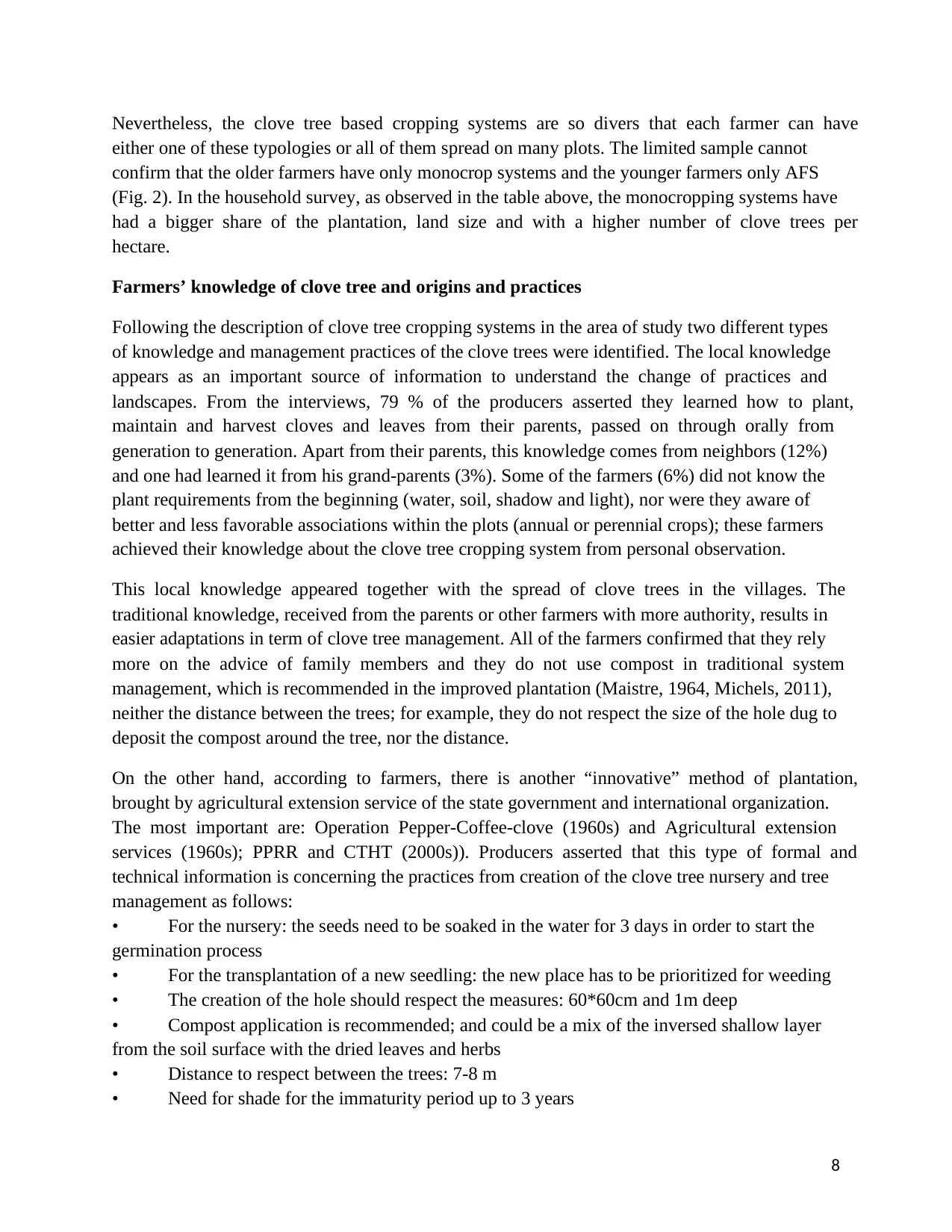
8
Nevertheless, the clove tree based cropping systems are so divers that each farmer can have
either one of these typologies or all of them spread on many plots. The limited sample cannot
confirm that the older farmers have only monocrop systems and the younger farmers only AFS
(Fig. 2). In the household survey, as observed in the table above, the monocropping systems have
had a bigger share of the plantation, land size and with a higher number of clove trees per
hectare.
Farmers’ knowledge of clove tree and origins and practices
Following the description of clove tree cropping systems in the area of study two different types
of knowledge and management practices of the clove trees were identified. The local knowledge
appears as an important source of information to understand the change of practices and
landscapes. From the interviews, 79 % of the producers asserted they learned how to plant,
maintain and harvest cloves and leaves from their parents, passed on through orally from
generation to generation. Apart from their parents, this knowledge comes from neighbors (12%)
and one had learned it from his grand-parents (3%). Some of the farmers (6%) did not know the
plant requirements from the beginning (water, soil, shadow and light), nor were they aware of
better and less favorable associations within the plots (annual or perennial crops); these farmers
achieved their knowledge about the clove tree cropping system from personal observation.
This local knowledge appeared together with the spread of clove trees in the villages. The
traditional knowledge, received from the parents or other farmers with more authority, results in
easier adaptations in term of clove tree management. All of the farmers confirmed that they rely
more on the advice of family members and they do not use compost in traditional system
management, which is recommended in the improved plantation (Maistre, 1964, Michels, 2011),
neither the distance between the trees; for example, they do not respect the size of the hole dug to
deposit the compost around the tree, nor the distance.
On the other hand, according to farmers, there is another “innovative” method of plantation,
brought by agricultural extension service of the state government and international organization.
The most important are: Operation Pepper-Coffee-clove (1960s) and Agricultural extension
services (1960s); PPRR and CTHT (2000s)). Producers asserted that this type of formal and
technical information is concerning the practices from creation of the clove tree nursery and tree
management as follows:
• For the nursery: the seeds need to be soaked in the water for 3 days in order to start the
germination process
• For the transplantation of a new seedling: the new place has to be prioritized for weeding
• The creation of the hole should respect the measures: 60*60cm and 1m deep
• Compost application is recommended; and could be a mix of the inversed shallow layer
from the soil surface with the dried leaves and herbs
• Distance to respect between the trees: 7-8 m
• Need for shade for the immaturity period up to 3 years
Nevertheless, the clove tree based cropping systems are so divers that each farmer can have
either one of these typologies or all of them spread on many plots. The limited sample cannot
confirm that the older farmers have only monocrop systems and the younger farmers only AFS
(Fig. 2). In the household survey, as observed in the table above, the monocropping systems have
had a bigger share of the plantation, land size and with a higher number of clove trees per
hectare.
Farmers’ knowledge of clove tree and origins and practices
Following the description of clove tree cropping systems in the area of study two different types
of knowledge and management practices of the clove trees were identified. The local knowledge
appears as an important source of information to understand the change of practices and
landscapes. From the interviews, 79 % of the producers asserted they learned how to plant,
maintain and harvest cloves and leaves from their parents, passed on through orally from
generation to generation. Apart from their parents, this knowledge comes from neighbors (12%)
and one had learned it from his grand-parents (3%). Some of the farmers (6%) did not know the
plant requirements from the beginning (water, soil, shadow and light), nor were they aware of
better and less favorable associations within the plots (annual or perennial crops); these farmers
achieved their knowledge about the clove tree cropping system from personal observation.
This local knowledge appeared together with the spread of clove trees in the villages. The
traditional knowledge, received from the parents or other farmers with more authority, results in
easier adaptations in term of clove tree management. All of the farmers confirmed that they rely
more on the advice of family members and they do not use compost in traditional system
management, which is recommended in the improved plantation (Maistre, 1964, Michels, 2011),
neither the distance between the trees; for example, they do not respect the size of the hole dug to
deposit the compost around the tree, nor the distance.
On the other hand, according to farmers, there is another “innovative” method of plantation,
brought by agricultural extension service of the state government and international organization.
The most important are: Operation Pepper-Coffee-clove (1960s) and Agricultural extension
services (1960s); PPRR and CTHT (2000s)). Producers asserted that this type of formal and
technical information is concerning the practices from creation of the clove tree nursery and tree
management as follows:
• For the nursery: the seeds need to be soaked in the water for 3 days in order to start the
germination process
• For the transplantation of a new seedling: the new place has to be prioritized for weeding
• The creation of the hole should respect the measures: 60*60cm and 1m deep
• Compost application is recommended; and could be a mix of the inversed shallow layer
from the soil surface with the dried leaves and herbs
• Distance to respect between the trees: 7-8 m
• Need for shade for the immaturity period up to 3 years
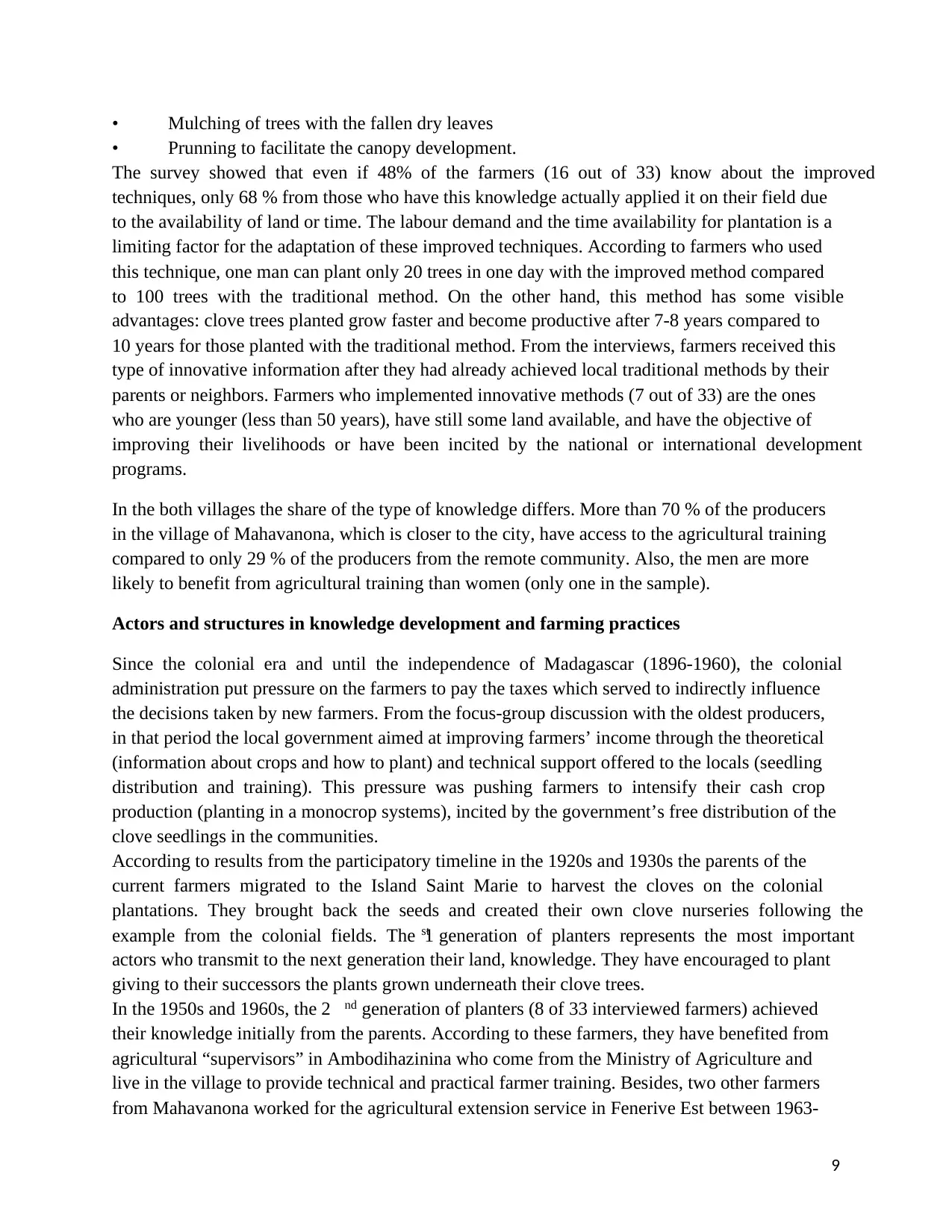
9
• Mulching of trees with the fallen dry leaves
• Prunning to facilitate the canopy development.
The survey showed that even if 48% of the farmers (16 out of 33) know about the improved
techniques, only 68 % from those who have this knowledge actually applied it on their field due
to the availability of land or time. The labour demand and the time availability for plantation is a
limiting factor for the adaptation of these improved techniques. According to farmers who used
this technique, one man can plant only 20 trees in one day with the improved method compared
to 100 trees with the traditional method. On the other hand, this method has some visible
advantages: clove trees planted grow faster and become productive after 7-8 years compared to
10 years for those planted with the traditional method. From the interviews, farmers received this
type of innovative information after they had already achieved local traditional methods by their
parents or neighbors. Farmers who implemented innovative methods (7 out of 33) are the ones
who are younger (less than 50 years), have still some land available, and have the objective of
improving their livelihoods or have been incited by the national or international development
programs.
In the both villages the share of the type of knowledge differs. More than 70 % of the producers
in the village of Mahavanona, which is closer to the city, have access to the agricultural training
compared to only 29 % of the producers from the remote community. Also, the men are more
likely to benefit from agricultural training than women (only one in the sample).
Actors and structures in knowledge development and farming practices
Since the colonial era and until the independence of Madagascar (1896-1960), the colonial
administration put pressure on the farmers to pay the taxes which served to indirectly influence
the decisions taken by new farmers. From the focus-group discussion with the oldest producers,
in that period the local government aimed at improving farmers’ income through the theoretical
(information about crops and how to plant) and technical support offered to the locals (seedling
distribution and training). This pressure was pushing farmers to intensify their cash crop
production (planting in a monocrop systems), incited by the government’s free distribution of the
clove seedlings in the communities.
According to results from the participatory timeline in the 1920s and 1930s the parents of the
current farmers migrated to the Island Saint Marie to harvest the cloves on the colonial
plantations. They brought back the seeds and created their own clove nurseries following the
example from the colonial fields. The 1st generation of planters represents the most important
actors who transmit to the next generation their land, knowledge. They have encouraged to plant
giving to their successors the plants grown underneath their clove trees.
In the 1950s and 1960s, the 2 nd generation of planters (8 of 33 interviewed farmers) achieved
their knowledge initially from the parents. According to these farmers, they have benefited from
agricultural “supervisors” in Ambodihazinina who come from the Ministry of Agriculture and
live in the village to provide technical and practical farmer training. Besides, two other farmers
from Mahavanona worked for the agricultural extension service in Fenerive Est between 1963-
• Mulching of trees with the fallen dry leaves
• Prunning to facilitate the canopy development.
The survey showed that even if 48% of the farmers (16 out of 33) know about the improved
techniques, only 68 % from those who have this knowledge actually applied it on their field due
to the availability of land or time. The labour demand and the time availability for plantation is a
limiting factor for the adaptation of these improved techniques. According to farmers who used
this technique, one man can plant only 20 trees in one day with the improved method compared
to 100 trees with the traditional method. On the other hand, this method has some visible
advantages: clove trees planted grow faster and become productive after 7-8 years compared to
10 years for those planted with the traditional method. From the interviews, farmers received this
type of innovative information after they had already achieved local traditional methods by their
parents or neighbors. Farmers who implemented innovative methods (7 out of 33) are the ones
who are younger (less than 50 years), have still some land available, and have the objective of
improving their livelihoods or have been incited by the national or international development
programs.
In the both villages the share of the type of knowledge differs. More than 70 % of the producers
in the village of Mahavanona, which is closer to the city, have access to the agricultural training
compared to only 29 % of the producers from the remote community. Also, the men are more
likely to benefit from agricultural training than women (only one in the sample).
Actors and structures in knowledge development and farming practices
Since the colonial era and until the independence of Madagascar (1896-1960), the colonial
administration put pressure on the farmers to pay the taxes which served to indirectly influence
the decisions taken by new farmers. From the focus-group discussion with the oldest producers,
in that period the local government aimed at improving farmers’ income through the theoretical
(information about crops and how to plant) and technical support offered to the locals (seedling
distribution and training). This pressure was pushing farmers to intensify their cash crop
production (planting in a monocrop systems), incited by the government’s free distribution of the
clove seedlings in the communities.
According to results from the participatory timeline in the 1920s and 1930s the parents of the
current farmers migrated to the Island Saint Marie to harvest the cloves on the colonial
plantations. They brought back the seeds and created their own clove nurseries following the
example from the colonial fields. The 1st generation of planters represents the most important
actors who transmit to the next generation their land, knowledge. They have encouraged to plant
giving to their successors the plants grown underneath their clove trees.
In the 1950s and 1960s, the 2 nd generation of planters (8 of 33 interviewed farmers) achieved
their knowledge initially from the parents. According to these farmers, they have benefited from
agricultural “supervisors” in Ambodihazinina who come from the Ministry of Agriculture and
live in the village to provide technical and practical farmer training. Besides, two other farmers
from Mahavanona worked for the agricultural extension service in Fenerive Est between 1963-
⊘ This is a preview!⊘
Do you want full access?
Subscribe today to unlock all pages.

Trusted by 1+ million students worldwide
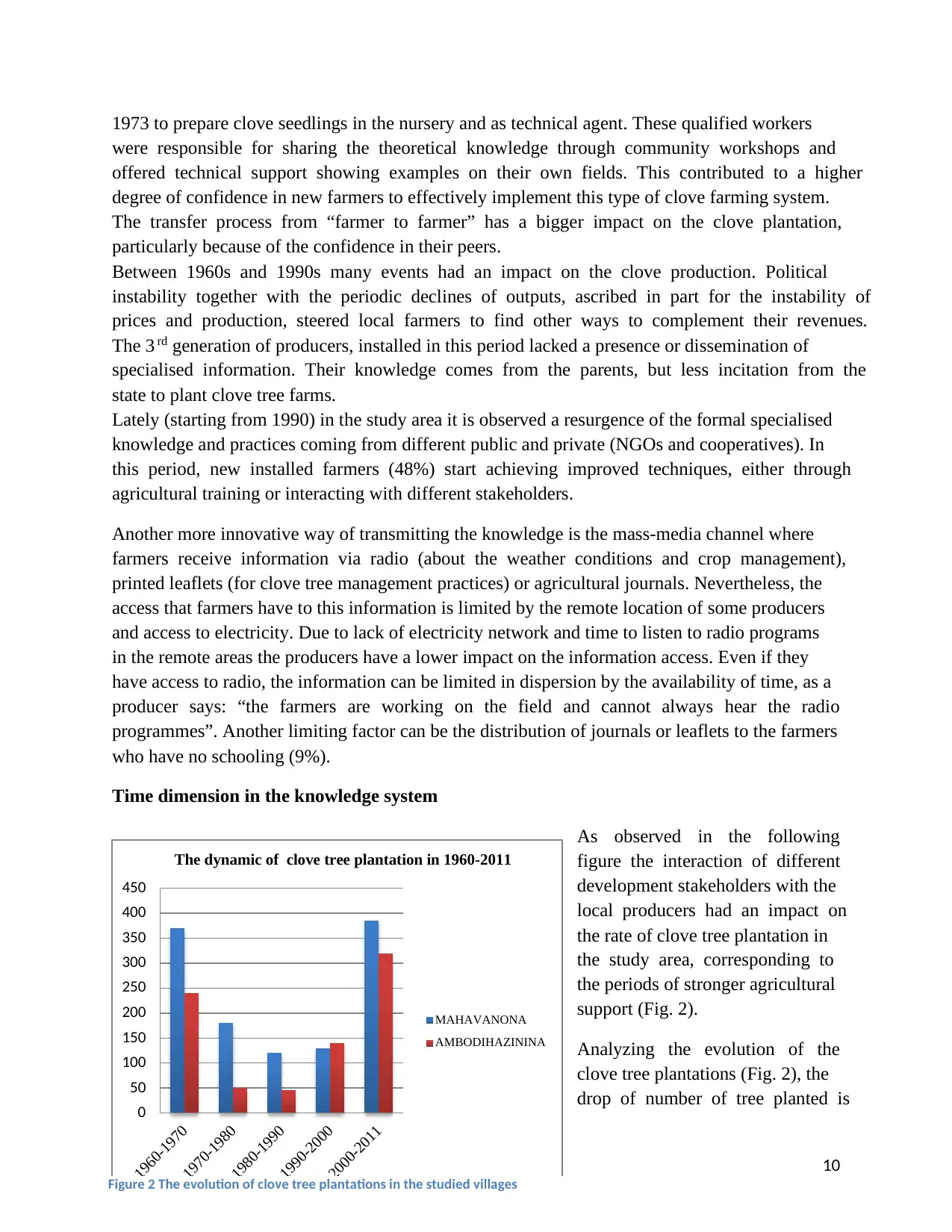
10
1973 to prepare clove seedlings in the nursery and as technical agent. These qualified workers
were responsible for sharing the theoretical knowledge through community workshops and
offered technical support showing examples on their own fields. This contributed to a higher
degree of confidence in new farmers to effectively implement this type of clove farming system.
The transfer process from “farmer to farmer” has a bigger impact on the clove plantation,
particularly because of the confidence in their peers.
Between 1960s and 1990s many events had an impact on the clove production. Political
instability together with the periodic declines of outputs, ascribed in part for the instability of
prices and production, steered local farmers to find other ways to complement their revenues.
The 3 rd generation of producers, installed in this period lacked a presence or dissemination of
specialised information. Their knowledge comes from the parents, but less incitation from the
state to plant clove tree farms.
Lately (starting from 1990) in the study area it is observed a resurgence of the formal specialised
knowledge and practices coming from different public and private (NGOs and cooperatives). In
this period, new installed farmers (48%) start achieving improved techniques, either through
agricultural training or interacting with different stakeholders.
Another more innovative way of transmitting the knowledge is the mass-media channel where
farmers receive information via radio (about the weather conditions and crop management),
printed leaflets (for clove tree management practices) or agricultural journals. Nevertheless, the
access that farmers have to this information is limited by the remote location of some producers
and access to electricity. Due to lack of electricity network and time to listen to radio programs
in the remote areas the producers have a lower impact on the information access. Even if they
have access to radio, the information can be limited in dispersion by the availability of time, as a
producer says: “the farmers are working on the field and cannot always hear the radio
programmes”. Another limiting factor can be the distribution of journals or leaflets to the farmers
who have no schooling (9%).
Time dimension in the knowledge system
As observed in the following
figure the interaction of different
development stakeholders with the
local producers had an impact on
the rate of clove tree plantation in
the study area, corresponding to
the periods of stronger agricultural
support (Fig. 2).
Analyzing the evolution of the
clove tree plantations (Fig. 2), the
drop of number of tree planted is
0
50
100
150
200
250
300
350
400
450
1960-1970
1970-1980
1980-1990
1990-2000
2000-2011
The dynamic of clove tree plantation in 1960-2011
MAHAVANONA
AMBODIHAZININA
Figure 2 The evolution of clove tree plantations in the studied villages
1973 to prepare clove seedlings in the nursery and as technical agent. These qualified workers
were responsible for sharing the theoretical knowledge through community workshops and
offered technical support showing examples on their own fields. This contributed to a higher
degree of confidence in new farmers to effectively implement this type of clove farming system.
The transfer process from “farmer to farmer” has a bigger impact on the clove plantation,
particularly because of the confidence in their peers.
Between 1960s and 1990s many events had an impact on the clove production. Political
instability together with the periodic declines of outputs, ascribed in part for the instability of
prices and production, steered local farmers to find other ways to complement their revenues.
The 3 rd generation of producers, installed in this period lacked a presence or dissemination of
specialised information. Their knowledge comes from the parents, but less incitation from the
state to plant clove tree farms.
Lately (starting from 1990) in the study area it is observed a resurgence of the formal specialised
knowledge and practices coming from different public and private (NGOs and cooperatives). In
this period, new installed farmers (48%) start achieving improved techniques, either through
agricultural training or interacting with different stakeholders.
Another more innovative way of transmitting the knowledge is the mass-media channel where
farmers receive information via radio (about the weather conditions and crop management),
printed leaflets (for clove tree management practices) or agricultural journals. Nevertheless, the
access that farmers have to this information is limited by the remote location of some producers
and access to electricity. Due to lack of electricity network and time to listen to radio programs
in the remote areas the producers have a lower impact on the information access. Even if they
have access to radio, the information can be limited in dispersion by the availability of time, as a
producer says: “the farmers are working on the field and cannot always hear the radio
programmes”. Another limiting factor can be the distribution of journals or leaflets to the farmers
who have no schooling (9%).
Time dimension in the knowledge system
As observed in the following
figure the interaction of different
development stakeholders with the
local producers had an impact on
the rate of clove tree plantation in
the study area, corresponding to
the periods of stronger agricultural
support (Fig. 2).
Analyzing the evolution of the
clove tree plantations (Fig. 2), the
drop of number of tree planted is
0
50
100
150
200
250
300
350
400
450
1960-1970
1970-1980
1980-1990
1990-2000
2000-2011
The dynamic of clove tree plantation in 1960-2011
MAHAVANONA
AMBODIHAZININA
Figure 2 The evolution of clove tree plantations in the studied villages
Paraphrase This Document
Need a fresh take? Get an instant paraphrase of this document with our AI Paraphraser
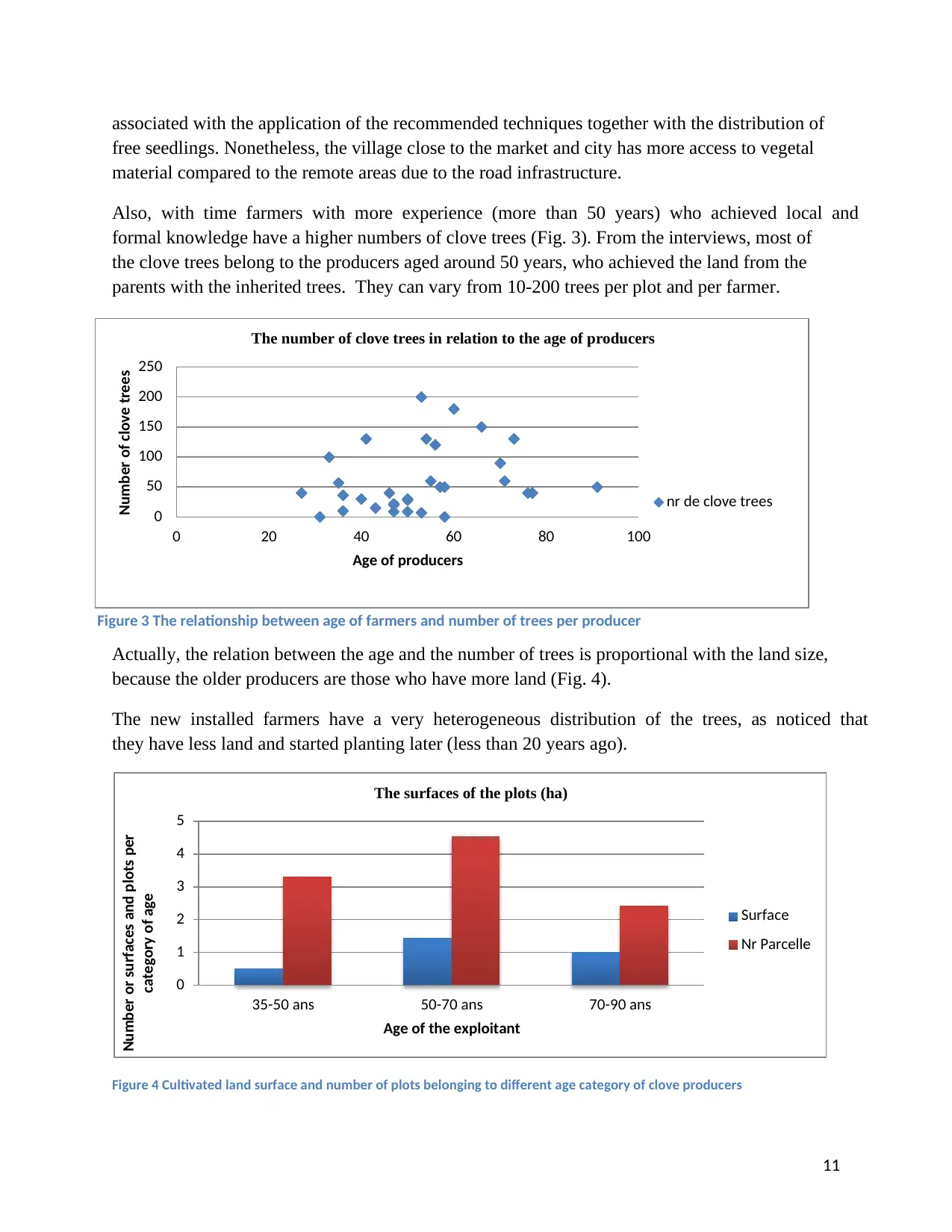
11
associated with the application of the recommended techniques together with the distribution of
free seedlings. Nonetheless, the village close to the market and city has more access to vegetal
material compared to the remote areas due to the road infrastructure.
Also, with time farmers with more experience (more than 50 years) who achieved local and
formal knowledge have a higher numbers of clove trees (Fig. 3). From the interviews, most of
the clove trees belong to the producers aged around 50 years, who achieved the land from the
parents with the inherited trees. They can vary from 10-200 trees per plot and per farmer.
Actually, the relation between the age and the number of trees is proportional with the land size,
because the older producers are those who have more land (Fig. 4).
The new installed farmers have a very heterogeneous distribution of the trees, as noticed that
they have less land and started planting later (less than 20 years ago).
Figure 4 Cultivated land surface and number of plots belonging to different age category of clove producers
0
1
2
3
4
5
35-50 ans 50-70 ans 70-90 ans
Number or surfaces and plots per
category of age
Age of the exploitant
The surfaces of the plots (ha)
Surface
Nr Parcelle
0
50
100
150
200
250
0 20 40 60 80 100
Number of clove trees
Age of producers
The number of clove trees in relation to the age of producers
nr de clove trees
Figure 3 The relationship between age of farmers and number of trees per producer
associated with the application of the recommended techniques together with the distribution of
free seedlings. Nonetheless, the village close to the market and city has more access to vegetal
material compared to the remote areas due to the road infrastructure.
Also, with time farmers with more experience (more than 50 years) who achieved local and
formal knowledge have a higher numbers of clove trees (Fig. 3). From the interviews, most of
the clove trees belong to the producers aged around 50 years, who achieved the land from the
parents with the inherited trees. They can vary from 10-200 trees per plot and per farmer.
Actually, the relation between the age and the number of trees is proportional with the land size,
because the older producers are those who have more land (Fig. 4).
The new installed farmers have a very heterogeneous distribution of the trees, as noticed that
they have less land and started planting later (less than 20 years ago).
Figure 4 Cultivated land surface and number of plots belonging to different age category of clove producers
0
1
2
3
4
5
35-50 ans 50-70 ans 70-90 ans
Number or surfaces and plots per
category of age
Age of the exploitant
The surfaces of the plots (ha)
Surface
Nr Parcelle
0
50
100
150
200
250
0 20 40 60 80 100
Number of clove trees
Age of producers
The number of clove trees in relation to the age of producers
nr de clove trees
Figure 3 The relationship between age of farmers and number of trees per producer
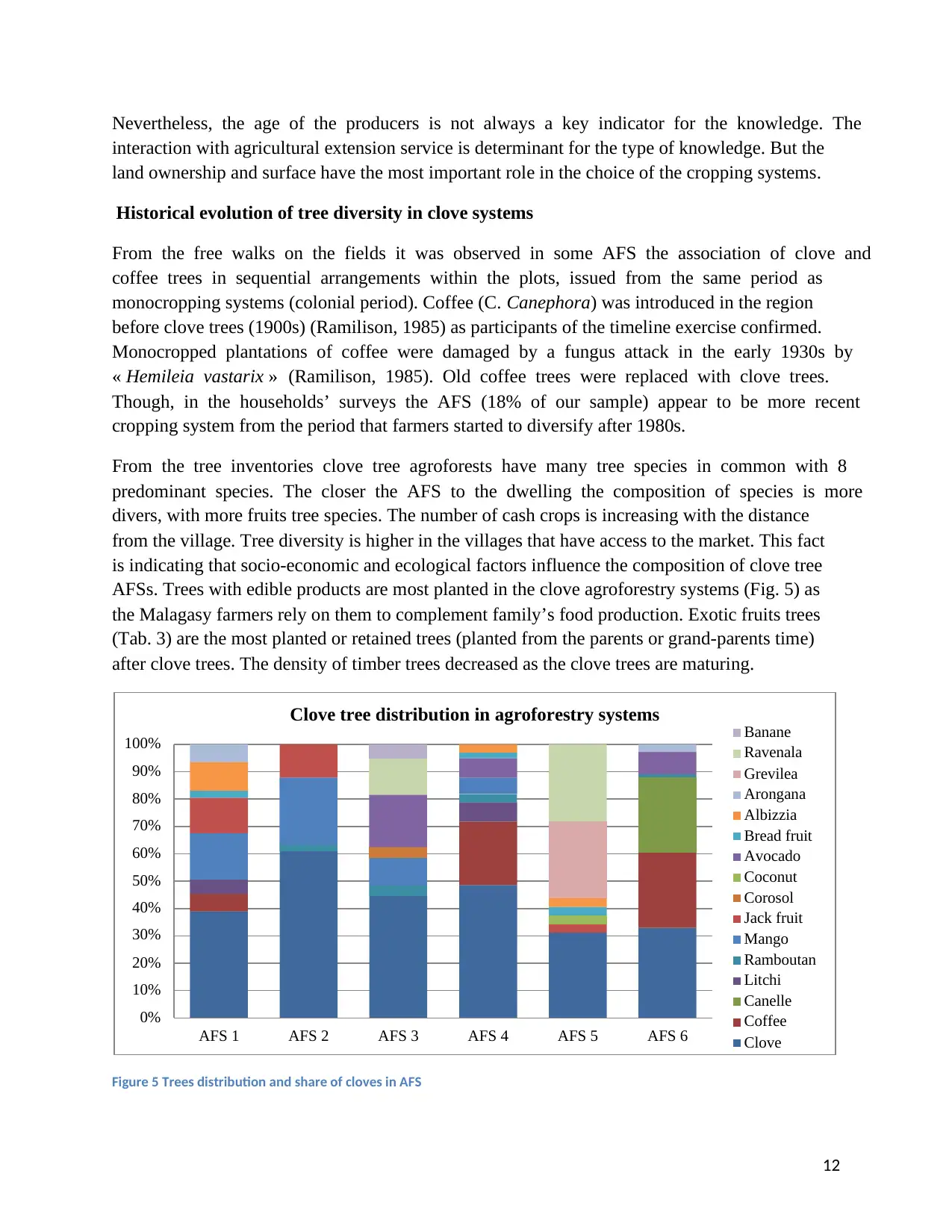
12
Nevertheless, the age of the producers is not always a key indicator for the knowledge. The
interaction with agricultural extension service is determinant for the type of knowledge. But the
land ownership and surface have the most important role in the choice of the cropping systems.
Historical evolution of tree diversity in clove systems
From the free walks on the fields it was observed in some AFS the association of clove and
coffee trees in sequential arrangements within the plots, issued from the same period as
monocropping systems (colonial period). Coffee (C. Canephora) was introduced in the region
before clove trees (1900s) (Ramilison, 1985) as participants of the timeline exercise confirmed.
Monocropped plantations of coffee were damaged by a fungus attack in the early 1930s by
« Hemileia vastarix » (Ramilison, 1985). Old coffee trees were replaced with clove trees.
Though, in the households’ surveys the AFS (18% of our sample) appear to be more recent
cropping system from the period that farmers started to diversify after 1980s.
From the tree inventories clove tree agroforests have many tree species in common with 8
predominant species. The closer the AFS to the dwelling the composition of species is more
divers, with more fruits tree species. The number of cash crops is increasing with the distance
from the village. Tree diversity is higher in the villages that have access to the market. This fact
is indicating that socio-economic and ecological factors influence the composition of clove tree
AFSs. Trees with edible products are most planted in the clove agroforestry systems (Fig. 5) as
the Malagasy farmers rely on them to complement family’s food production. Exotic fruits trees
(Tab. 3) are the most planted or retained trees (planted from the parents or grand-parents time)
after clove trees. The density of timber trees decreased as the clove trees are maturing.
Figure 5 Trees distribution and share of cloves in AFS
0%
10%
20%
30%
40%
50%
60%
70%
80%
90%
100%
AFS 1 AFS 2 AFS 3 AFS 4 AFS 5 AFS 6
Clove tree distribution in agroforestry systems Banane
Ravenala
Grevilea
Arongana
Albizzia
Bread fruit
Avocado
Coconut
Corosol
Jack fruit
Mango
Ramboutan
Litchi
Canelle
Coffee
Clove
Nevertheless, the age of the producers is not always a key indicator for the knowledge. The
interaction with agricultural extension service is determinant for the type of knowledge. But the
land ownership and surface have the most important role in the choice of the cropping systems.
Historical evolution of tree diversity in clove systems
From the free walks on the fields it was observed in some AFS the association of clove and
coffee trees in sequential arrangements within the plots, issued from the same period as
monocropping systems (colonial period). Coffee (C. Canephora) was introduced in the region
before clove trees (1900s) (Ramilison, 1985) as participants of the timeline exercise confirmed.
Monocropped plantations of coffee were damaged by a fungus attack in the early 1930s by
« Hemileia vastarix » (Ramilison, 1985). Old coffee trees were replaced with clove trees.
Though, in the households’ surveys the AFS (18% of our sample) appear to be more recent
cropping system from the period that farmers started to diversify after 1980s.
From the tree inventories clove tree agroforests have many tree species in common with 8
predominant species. The closer the AFS to the dwelling the composition of species is more
divers, with more fruits tree species. The number of cash crops is increasing with the distance
from the village. Tree diversity is higher in the villages that have access to the market. This fact
is indicating that socio-economic and ecological factors influence the composition of clove tree
AFSs. Trees with edible products are most planted in the clove agroforestry systems (Fig. 5) as
the Malagasy farmers rely on them to complement family’s food production. Exotic fruits trees
(Tab. 3) are the most planted or retained trees (planted from the parents or grand-parents time)
after clove trees. The density of timber trees decreased as the clove trees are maturing.
Figure 5 Trees distribution and share of cloves in AFS
0%
10%
20%
30%
40%
50%
60%
70%
80%
90%
100%
AFS 1 AFS 2 AFS 3 AFS 4 AFS 5 AFS 6
Clove tree distribution in agroforestry systems Banane
Ravenala
Grevilea
Arongana
Albizzia
Bread fruit
Avocado
Coconut
Corosol
Jack fruit
Mango
Ramboutan
Litchi
Canelle
Coffee
Clove
⊘ This is a preview!⊘
Do you want full access?
Subscribe today to unlock all pages.

Trusted by 1+ million students worldwide
1 out of 21
Your All-in-One AI-Powered Toolkit for Academic Success.
+13062052269
info@desklib.com
Available 24*7 on WhatsApp / Email
![[object Object]](/_next/static/media/star-bottom.7253800d.svg)
Unlock your academic potential
Copyright © 2020–2025 A2Z Services. All Rights Reserved. Developed and managed by ZUCOL.